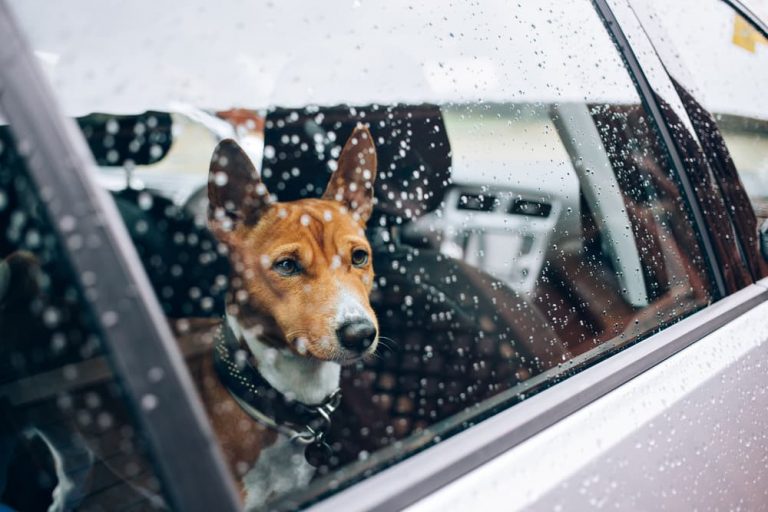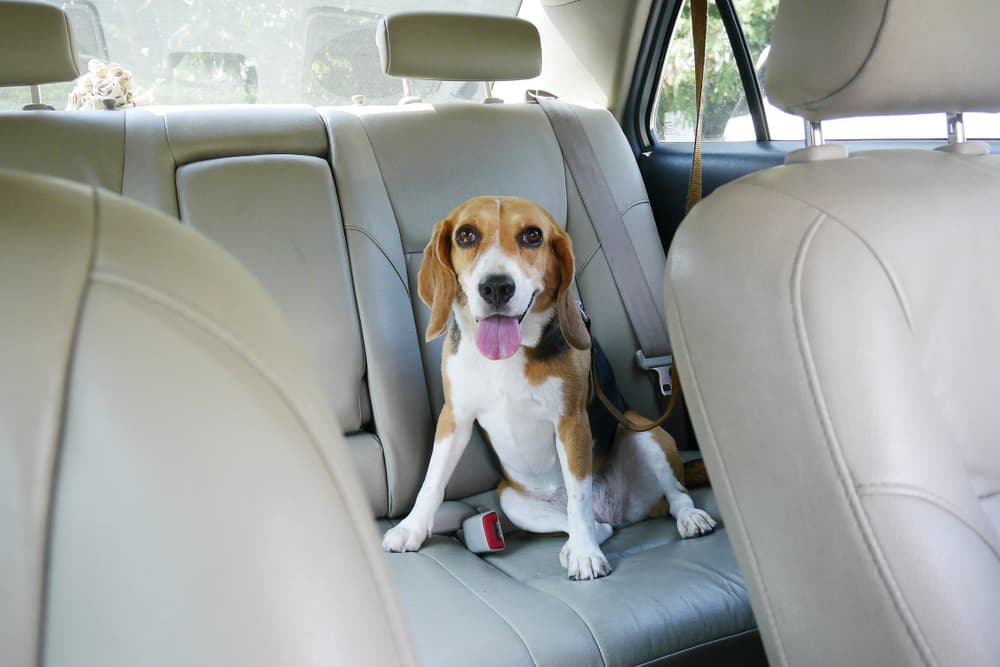Dog Car Anxiety: How to Make Trips Stress Free

Traveling with dogs takes plenty of planning. You have to stock up the car with snacks, food bowls, fresh water, toys, comfy blankets, and more. Add to that a dog with serious car anxiety, and prepping for a road trip or holiday travel can become even more stressful.
Dog car anxiety is a common problem that can be scary and upsetting for both of you. If it leads your pup to bother you when you’re behind the wheel, it can lead to dangerous driving conditions, too.
Thankfully, training and coping tools can help your pup enjoy (or at least tolerate) extended time on the road. Here’s everything you need to know about dog car anxiety including what it looks like, why it happens, and how to ease your little one’s nerves for a smoother ride.
Symptoms of Dog Car Anxiety

If your dog only seems stressed out when you’re about to get into the car or during a drive, that’s a pretty good sign that you’re dealing with car anxiety, says Dr. Katherine A. Houpt, a veterinarian and James Law Professor Emeritus of Behavior Medicine at Cornell University College of Veterinary Medicine.
Telltale signs of car-related anxiety in dogs include:
- Whining, panting, or excessive drooling
- Barking
- Pacing or trying to hide
- Yawning
- Lip-smacking
- Vomiting
- Having accidents in the car
- Aggression such as self-harm or biting others
If this sounds familiar, it helps to begin by learning what’s at the root of your dog’s anxiety.
Keep in mind that drooling and vomiting are also symptoms of car sickness. If what looks like car anxiety begins a few minutes or hours into the drive, queasiness from motion sickness may be to blame.
Dog Anxiety in the Car: Why it Happens

In many cases, the reason your pup is so nervous in the car is simple: “Most dogs have car anxiety because they are not exposed to traveling in the car enough,” says Dr. Sara Ochoa, a veterinarian based in Texas.
Other times, they’ve got a problem with the destination. “Some dogs have learned that a car ride means a trip to the veterinarian or groomer—which many dogs hate,” adds Dr. Ochoa. If your pup dreads veterinary appointments or having her nails trimmed, she could see your car as her personal taxi to the bad place.
Other negative associations could also be at play, adds Dr. Houpt, such as traumatic memories of a scary car accident or—for rescues—being abandoned outside a car.
How to Help Dogs With Car Anxiety

To determine the best dog car anxiety treatment for your little one, start by considering the severity of the situation. Are your lives deeply disrupted or is this a minor inconvenience?
If you’re afraid of having a car accident due to your dog’s behavior or she’s so jumpy you have to take frequent stops to have her “run off” excess energy, it’s time to consult with a veterinarian for professional help, says Dr. Houpt.
Depending on your pup’s symptoms, your veterinarian may advise that you start with lifestyle changes and behavioral training or suggest you come in to rule out related health issues like motion sickness.
Should they confirm a diagnosis, they can prescribe the most effective treatments available such as an anti-nausea medication like maropitant citrate (Cerenia) for motion sickness or a dog-friendly sedative for travel like trazodone (Desyrel) or diazepam (Valium, Diastat).



Once your pup’s gotten a clean bill of health, follow these tips to help ease car anxiety before your big trip.
Use Dog-Friendly Restraints

If you haven’t already, invest in a comfortable crate, car carrier, or doggy seatbelt to make your dog feel more secure and keep both of you safe.
Create Positive Associations
Teach your dog that the car equals treats. Choose a healthy, high-value training treat, such as Nutrisentials Lean Treats for Dogs, to gradually ease your dog closer to the car. Start by feeding her outside your vehicle, then at the foot of the car, and—eventually—in the backseat, suggests Dr. Houpt.

Pair these sessions with trick training, meals, and quality bonding time. In dog training-speak, this process helps desensitize her to your car with counter-conditioning by replacing negative associations with more positive ones.
Take Joy Rides
After your dog has adjusted to the idea of getting into the car, slowly begin to introduce her to going out on rides. Start your engine and give positive reinforcement like treats and praise, then begin to take small trips to fun places like the dog park or her favorite neighbor’s house.
Keep Your Dog Comfortable

During drives, cover basic creature comforts to ease your dog’s nerves. Turn up the A/C on hot days, don’t play music too loud, avoid yelling or startling your dog, and never leave her in the car unattended. Heat stroke and hypothermia can happen fast, and they’re not worth the risk.
Make Regular Pit Stops
As far as breaks for the bathroom, water, and meals go, stick to your dog’s usual schedule as much as possible, says Dr. Houpt. If you typically feed her at 5 p.m. sharp, schedule a dinner break at that time during a road trip too.
Consider Calming Supplements
“You can also try anti-anxiety supplements before travel,” says Dr. Ochoa. While more research is needed on some over-the-counter remedies, they could help your dog stay calm. Plus, anti-anxiety solutions come in various forms, from supplement powders and chews to calming sprays. Ask your veterinarian if one of these options would be a good choice for your pet.



Be Patient and Don’t Push
It can take time for dogs to adjust, so remember it’s okay to take a step back if she panics and continue gradually moving forward until your dog feels fully comfortable in the car.









